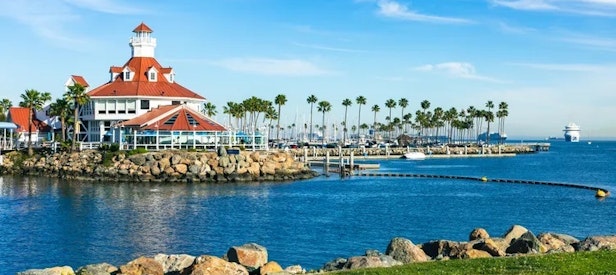History of the U.S. Navy in Long Beach
Long Beach–the name conjures up images of sun, sand and one of the world’s great ports. What is sometimes lost in that picture is that for much of the 20th century, Long Beach was also a major U.S. Navy town. From the early years of the century through the Cold War, the Navy’s presence shaped the city’s economy, identity, and growth, helping transform a seaside town into a dynamic coastal urban center.
World War I
The Navy’s connection to Long Beach began in 1917 with the establishment of the Long Beach Naval Reserve Armory, anticipating America’s entry into World War I. In the 1930s, the Navy commissioned the Long Beach Naval Station and an adjacent Naval Shipyard, cementing the city’s role as a strategic port and fueling rapid growth in infrastructure and population.
World War II
World War II would mark a high point for Long Beach's naval activity as the shipyard operated around the clock to repair and construct vessels for the Pacific Theater. Thousands of service members and civilian workers flooded into the city, boosting employment and triggering the rapid development of housing, schools, and neighborhoods. Downtown expanded, and the Port of Long Beach began its transformation into a global commercial hub.
The influx of sailors also shaped the city’s cultural identity. Long Beach became a hotspot for tattooing, as servicemen sought to commemorate their tours with ink. This tradition helped foster one of the most influential tattoo cultures in the world, now deeply embedded in the city’s artistic scene.
Cold War Era
Long Beach’s military relevance extended well into the Cold War. The Naval Station served as homeport for major aircraft carriers, including the USS Ranger, Constellation, and Kitty Hawk. The city regularly hosted fleet weeks and parades, reinforcing its status as a proud Navy town. In 1966, the USS Long Beach, the first nuclear-powered surface combatant, reflected the city’s strategic and technological significance.The construction of the Long Beach Breakwater from 1941 to 1949 further underlined the Navy’s influence. Built to protect ships and port facilities, it also reshaped the coastline by calming wave activity. Once a prime spot for surfing, the beach’s character shifted to family recreation, altering both its ecological balance and cultural rhythm.
Post-Cold War
The Navy's presence even influenced the city’s cultural institutions. The building that now houses the Long Beach Museum of Art, this historic 1911 Elizabeth Milbank Anderson House, was used during World War II as a Chief Petty Officers’ Club.
In the early 1990s, the Cold War’s end brought defense cuts and in 1994 the Base Realignment and Closure commission ordered the shutdown of both the Naval Station and the Shipyard. Though this marked the end of Long Beach’s formal military era, it opened the door to ambitious redevelopment.
Former Navy land was repurposed into commercial and industrial zones, most notably the Long Beach Container Terminal, now one of the most advanced in the world. The shift spurred economic diversification while maintaining the city’s maritime focus.
An Enduring Legacy
While the Navy’s physical presence has faded, its legacy endures. Federal investment and military-driven population growth helped lay the groundwork for a diverse, economically resilient city. Memorials, museums, and repurposed buildings across Long Beach honor a century of naval history, most notably The Lone Sailor statue located at Bluff Park that looks out to the ocean to honor the fallen.
Though it’s no longer a Navy town in the traditional sense, Long Beach remains anchored in its maritime roots, its past still shaping its future.
2300 East Ocean Boulevard
Long Beach, California 90803
(562) 439-2119
Website
LONG BEACH MUSEUM OF ART2300 East Ocean Boulevard
Long Beach, California 90803
4801 Airport Plaza Drive
Long Beach, California 90807
(562) 590-4121
Website
THE PORT OF LONG BEACH4801 Airport Plaza Drive
Long Beach, California 90807











